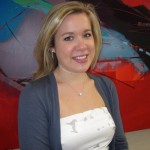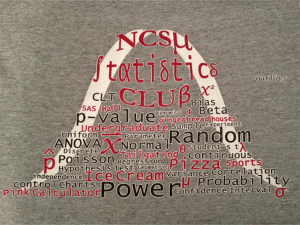
As a recent Master’s of Science in Advanced Analytics grad, Sarah Watson has a fresh take on the statistical sciences profession. And she’s excited about the long overdue attention it’s getting with today’s businesses. It seems the growing popularity of statistics is no longer an outlier. A marketing analyst for JMP, she understands the potential power behind all the data companies collect. Check out Sarah’s story and also be sure to read the rest of the SAS loves stats series as we focus on the International Year of Statistics.
What do you do at SAS?
I am a database marketing analyst in the JMP division. As part of the database marketing team, I help support our global marketing and sales teams.
What’s your educational background?
I completed my undergraduate studies at NC State with a BA in statistics in 2010, and went directly into the Institute for Advanced Analytics for my master’s degree. My current job here at SAS is actually my first job. I started as a summer intern after my sophomore year of college and was lucky to get hired full time after completing my degrees as an analyst. For my final team project in the analytics program at NC State, I helped analyze and model attributes for a new credit scorecard for a bank. It was really interesting for me because my undergraduate studies were so theoretical, and this project showed me what real data is like. For instance, banks sometimes have to manage variables in the hundreds!
How do you use statistics in your job?
I use my statistics and analytics background in several different ways in my current job. I use statistical programming, through SAS and JMP, to query our internal databases. I have learned our scripting language, JSL, to write custom JMP add-ins for our global sales team. I also use statistics to continually build on our knowledge of our customers – especially in terms of how successful our marketing efforts are, and the best way we can communicate through email marketing and advertising. To support our internal teams, I have built reports and dashboards as we continue to build on what data we monitor and how to manage workload.
What about statistics appeals to you?
The fact that statistics is used, and necessary, in just about every industry has always been appealing to me. Now that I work at SAS, I see all the ways our software is used and all the different problems it helps solve. And it’s really amazing. As an undergraduate, I learned about all the opportunities for statisticians, which really persuaded me to continue down that path. I knew I could apply those skills to any area I might be interested in later in life. I also love getting into the data and making new discoveries that could help aid business decisions. Simply finding things that stand out will always be appealing to me. Statistics is really practical, and you can see it everywhere in life.
Can you comment on the importance of statistics in education?
I think statistics has always been important in education, but it is even more so now that we are surrounded by data. In fact, my grandma just last week sent me an article from our local newspaper that said our educational system should build up to a foundation in statistics, not calculus. Calculus is very specific to certain careers, and those not interested find it hard to picture how they will use it. No matter what your career is, the results of statistics are everywhere: in surveys, poll predictions/game predictions, and marketing data from stores and companies. Having some foundation in statistics is beneficial to anyone who wants to understand how those numbers and results are reached. Especially since the computing power we have now makes data analysis faster than ever. Knowing how to dig into data and find answers will come in handy in any career.
What advice would you give to students studying statistics today?
My advice as a recent graduate would be to really think about which industry you want to apply your statistical skills to. I think it’s easy to get wrapped up in the theoretical side of statistics, but I would encourage students to also think about the applied side of things. Try to figure out what sort of problem would make you excited to use statistics. The Institute for Advanced Analytics really connected the dots for me on how statistics is used in the business world. It exposed me to so many applications of statistics I was able to decide which problems were most interesting to me. Once you figure out which application fits you best, work on making connections in that area and learning about the kinds of ways those problems are solved. For me, after learning about marketing analytics, I knew that was an interest of mine and really got into that class in the analytics program.

Do you have a funny or interesting story to share about statistics?
When I was president of the NC State Statistics Club, my friend (who was also in it) and I stayed up till 4 am one night designing a club t-shirt that had some statistics jokes on it… and it was in the shape of a normal distribution.
Do you have a favorite statistics blog or journal?
I like to read AnnMaria’s Blog and Avinash Kaushik’s blog. I also read some other marketing analytics focused blogs as well.
Do you have a favorite statistician?
As a female graduate of NC State, I will be predictable and say my favorite statistician is Gertrude Cox. She founded the statistics department at NC State and became the first female president of the ASA.
Are there any other hobbies or interests you’d like to share?
One of my hobbies is to design the 3D graphics for iOS games. Currently, there are two games I have designed in the App Store. I’ve been able to use my statistics background for this as well, digging into the game score data and looking at difficulty levels for each game.

1 Comment
Thanks for sharing your background. Also I love the outlier in your NC State Statistics Club t-shirt design!